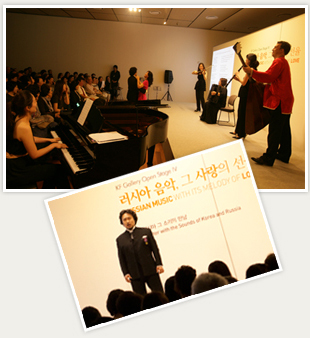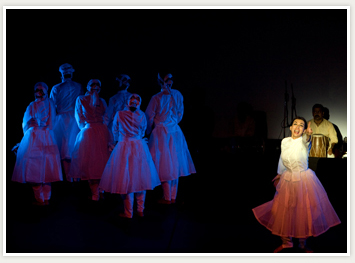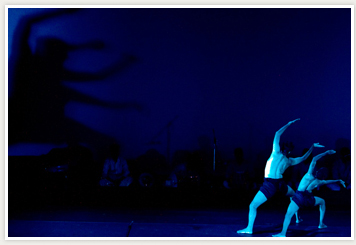‘An Encounter with Sounds of Korea and Russia’
Russian Songs Resonant with Profound Sensibility
From the melancholy melody of a mandolin from the soundtrack of the movie “Doctor Zhivago” to the resonant bass of the theme song of the popular Korean TV drama “The Sandglass,” Russian music has enchanted Koreans with its unique sentimental appeal. As such, the fourth session of KF Gallery Open Stage on August 21 enthralled hundreds of music lovers with a program entitled “An Encounter with the Sounds of Korea and Russia: Russian Music with its Melody of Love.”
The concert was the first event held at the Korea Foundation Cultural Center since it moved to its new location in July. In her welcoming remarks, Yoon Keum-jin, director of the KF Cultural Center, said: “Today, we received a number of inquiries for directions as to how to get to our center. So, now that you know where we are, please come and visit us often.”
The concert began with bass Lee Yun-sung singing the “Song of the Volga Boatman” and “Coachman, Spare Your Horses!” As the audience gradually became immersed with the mood of Russian music, “A Million Red Roses” (better known through a song by Shim Su-bong in Korea sung by the popular Russian singer Alla Pugacheva flowed out from the stage. Accompanied by two traditional Russian musical instruments, the bayan (a kind of accordion) and balalaika (similar to a mandolin), the song’s authentic Russian melody mesmerized the audience.
 Appeal of Russian Music
Appeal of Russian Music
The concert featured a diverse range of genres, including instrumental pieces, pop songs, folk songs, and ballads. Still, the Korean audience expressed more interest in works they were familiar with, including “Libertango,” which enjoyed great popularity after being introduced as a cello rendition in a Korean TV drama; “By the Long Road,” adapted into the song “Those Were the Days” by the popular British singer Mary Hopkins; and “Kakyusha,” a famous Russian folk song which became widely known among the young generation as background music for a video game. As these tunes were played, the audience hummed along, clapping their hands enthusiastically. Moreover, Lee Yun-sung drew big applauses by coming down from the stage and dancing with a member of the audience while singing Shostakovich’s “Jazz Suite No. 2, Op. 50b, Waltz II.”
Narta, a Russian music ensemble consisting of Korean musicians who have studied in Moscow, performed in the concert. The group has tried to promote Russian music in Korea. For the finale, Lee Yun-sung returned to the stage to sing an encore of “Cranes,” which is widely known among the Koreans as the theme song of the TV drama “The Sandglass.” The concert was too short for the audience to fully appreciate Russia’s rich musical tradition, but they obviously left with enduring echoes in their hearts.
‘India – Then, Now and Forever’
A Summer Night of Exquisite Indian Dance
 On August 3, the intermittent spells of rain did little to deter the world-renowned Indian dancer Mallika Sarabhai and her contemporary dance group from staging a splendid performance at the Kaya Theater in central Seoul. The special performance was jointly organized by the Korea Foundation and the Indian Council for Cultural Relations (ICCR) in conjunction with the “Year of Korea-India Cultural Exchanges 2011,” which is being celebrated by both countries. As the leading institution for cultural and public diplomacy of their respective country, the KF and the ICCR signed a memorandum of understanding in 2010 to promote mutual cooperation in the field of cultural exchanges. The two organizations have maintained a cooperative relationship since they jointly presented an Indian Buddhist art exhibition at the KF Cultural Center in 2006. The Son Kyung-soon Dance Company of Korea will perform in India in November to reciprocate the performance by Sarabhai and her Darpana Contemporary Dance Troupe in Seoul.
On August 3, the intermittent spells of rain did little to deter the world-renowned Indian dancer Mallika Sarabhai and her contemporary dance group from staging a splendid performance at the Kaya Theater in central Seoul. The special performance was jointly organized by the Korea Foundation and the Indian Council for Cultural Relations (ICCR) in conjunction with the “Year of Korea-India Cultural Exchanges 2011,” which is being celebrated by both countries. As the leading institution for cultural and public diplomacy of their respective country, the KF and the ICCR signed a memorandum of understanding in 2010 to promote mutual cooperation in the field of cultural exchanges. The two organizations have maintained a cooperative relationship since they jointly presented an Indian Buddhist art exhibition at the KF Cultural Center in 2006. The Son Kyung-soon Dance Company of Korea will perform in India in November to reciprocate the performance by Sarabhai and her Darpana Contemporary Dance Troupe in Seoul.
Influence of Religion
The full house audience consisted of Indian nationals residing in Korea and Koreans who had anxiously awaited the performance by the world-famous Indian dancer and her group. Titled “India – Then, Now and Forever,” the performance provided insight into the past and present of the time-honored culture and arts of India by portraying the characteristics of Indian performing arts, which are closely related with the country’s religious and philosophical traditions.

The performance began with a text projection on the screen, which read: “Well ahead of the existence of Vedic Culture, there lived people in India and their songs and dances spread all over the world. Commonly called ‘aboriginals,’ they discovered the sound of their own and this sound resonated throughout the world.” Then, dancers dressed in the costumes of India’s native Ratwa tribe appeared on the stage. Indians believe that the Ratwa tribe was one of the first human races on earth, hence their dance movements were dramatic to express a primitive character. The movements were simple but artistic enough to clearly suggest the ancient Indians’ profound insight for the arts.
 The group went on to perform “Navasandi,” from the classical dance “Bharatanatyam,” which praises the God of Fire. Then, Shiva appeared as the supreme god of “Bharatanatyam,” while the dancers depicted the amazing story of Mahabharata which is regarded as the greatest Sanskrit epic of ancient India. Consisting of various dances including group, solo, and duet works, the performance sought to overcome the constraints of time and space by incorporating folk dances of ancient tribes and abstract contemporary pieces. Most notably, the dancers captivated the audience with skillful facial s and bodily gestures, in addition to dance techniques, to portray eternal deities and man’s worship of them.
The group went on to perform “Navasandi,” from the classical dance “Bharatanatyam,” which praises the God of Fire. Then, Shiva appeared as the supreme god of “Bharatanatyam,” while the dancers depicted the amazing story of Mahabharata which is regarded as the greatest Sanskrit epic of ancient India. Consisting of various dances including group, solo, and duet works, the performance sought to overcome the constraints of time and space by incorporating folk dances of ancient tribes and abstract contemporary pieces. Most notably, the dancers captivated the audience with skillful facial s and bodily gestures, in addition to dance techniques, to portray eternal deities and man’s worship of them.
In the final act of “Kaun” (Who), all the dancers wore a mask on their faces and held two other masks in hands while dancing to search for the answer to the question: “What is freedom, life, and truth?” The dance led the audience to think about the philosophical question. For Sarabhai, who is called a brilliant dancing warrior, dance is not only an artistic act but also a beautiful language to express her beliefs. At the conclusion the 90-minute performance, the audience gave a rousing ovation to Sarabhai and her dance troupe, who offered a glimpse into Indian culture through the universal language of dance.
At the post-show reception, Indians dressed in their national costumes and Koreans mingled together in a friendly atmosphere. Zeon Nam-jin, executive vice president of the Korea Foundation, proposed a toast, saying: “I would like to thank all concerned officials at the Indian Embassy in Korea, who spared no efforts for the success of today’s performance. Through this event, Korea and India have become closer to understand each other better and, based on our increased mutual understanding, I hope our friendship will be further enhanced.” The guests toasted to celebrate the memorable cultural event for both nations.
Mallika Sarabhai
With the nickname “a brilliant dancing warrior,” Mallika Sarabhai received enthusiastic applauses from the audience for her aesthetic dance works searching for the truth. In India, she is renowned for her energetic activities as a movie actress, CEO of a TV station and a social activist fight against injustice, as well as a world-class dancer.
Choi Kyung-sook
 한국국제교류재단
한국국제교류재단












